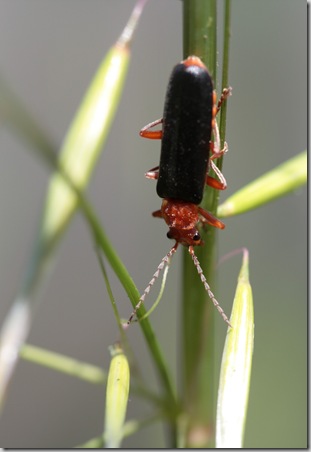On the heels of our recent Garden Designers Roundtable on Inviting Nature Into the Garden, I wanted to share a resource that I’ve been finding incredibly helpful in recent months. While we all know that planting natives is a good way to attract more life into our gardens, if we only have space for a couple of plants, it can be hard to know which ones will have the biggest impact.
This list shares ten of the highest-impact natives you can plant to support multiple types of wildlife in your coastal Northern California garden.
This article is republished with permission from the author, Peter Haggard. It was originally published in the August 2009 edition of EcoNews.
Trees:
Red Alder (Alnus rubra):
Young red alders provide food for leaf- and root-feeding insects and mammals. As they age they provide food for larger populations of leaf- and root-feeding insects and mammals and food and homes for cavity-nesting wildlife, including woodpeckers, sapsuckers, owls, and flying squirrels.
Willows (Salix spp.):
Provide most of the same benefits as red alders but there is a large selection of species from which we can choose.
 Shrubs:
Shrubs:
Manzanita (Arctostaphylos spp.):
One of the first plants to flower in winter to early spring and as such it is extremely important to native bees and hummingbirds.
Ceanothus (Ceanothus spp.):
Produce flowers in abundance for beauty, and the pollen, nectar and leaves are relished by insects and mammals.
Twinberry (Lonicera involucrata):
Start blooming early and continue much of the summer if provided with water. Flowers provide nectar for hummingbirds and long-tongued insects. The berries are a much sought after food by fruit-eating birds.
California Wax Myrtle (Morella californica):
Fruits last into the winter and provide food for local and migrating birds when other foods are scarce.
Currant & Gooseberry (Ribes spp.)
Flowers, fruit, and leaves provide food for bees, birds, and butterflies.
Herbaceous Perennials:
Aster (Aster spp.):
Bloom mid-summer to fall when other flowers are scarce, and the leaves are larval food for butterflies.
Clarkia (Clarkia spp.):
Produce huge numbers of flowers when many native bees are active.
Wild Buckwheat (Eriogonum spp.):
Flowers and foliage are food for native bees and butterflies.
Notes:
Choose native plants endemic to where you garden.
For this list no wildlife (except Homo sapiens) was consulted.
 Peter Haggard is the Garden Chair of the California Native Plant Society – North Coast Chapter, and co-author with Judy Haggard of Insects of the Pacific Northwest
Peter Haggard is the Garden Chair of the California Native Plant Society – North Coast Chapter, and co-author with Judy Haggard of Insects of the Pacific Northwest, published by Timber Press. His insect guide is my go-to book when I find a crazy new bug in the garden, and if you live in the Pacific Northwest, I highly recommend you pick up a copy.
Further Resources:
10 responses to “The Ten Best Native Plants for Coastal Northern California Wildlife by Peter Haggard”
Ceaonothus has my vote. I would probably choose either Julia Phelps, but still a sucker for Carmel Creeper…Ceanothus griseus var. horizontalis
My fav ceanothus is Concha – but I am in so Cal, so may be different conditions up there. I LOVE that blue. Strong colors suit me and my garden. But for clients, I like to pull in softer colors, as their personalities’ guide selelctions.
Thanks for the tips, Gen. I’m always a sucker for Ceanothus, but have also had great luck with the Buckwheats (if I can just get my clients to STOP overwatering them!).
I love Ceanothus too, you guys. My favorite is Dark Star. Rebecca, I haven’t yet tried any buckwheats, I’m embarrassed to say. I’m glad my local native plant society’s having a plant sale in two weeks. I’ll pick a few up – I’m good with benign neglect.
Sweet – nearly all of those (and many more) are growing here already – and I didn’t have to do a thing! Some of them in fact are becoming rather a nuisance; Ceanothus is quite fecund and keeps popping up where it’s in the way, but it’s so pretty I hate to yank it out.
Another native that makes great habitat, but can be quite a nuisance, is Coyote Bush (Baccharis pilularis). White-crowned Sparrows in particular seem particularly fond of it; they nest in the bushes in Spring, then gorge on the seeds in Fall. It blooms very late in summer/fall, so is probably a key source of nectar after most other flowers have dried up. Not sure if it’s ever used as a landscape plant, but it is practically unkillable and could undoubtedly be pruned however you’d like it. (Unlike the native Ceanothus here, which hates being cut.)
[…] share many natives with the Pacific Northwest and a few with the rest of California, so this side garden has our native vine maple, Acer circinatum, Smith’s fairy bells, […]
[…] share many natives with the Pacific Northwest and a few with the rest of California, so this side garden has our native vine maple, Acer circinatum, Smith’s fairy bells, […]
[…] water-conserving and native plants that are well-adapted to your garden and need little supplemental care. They’ll still need […]
[…] Attracting Wildlife with Native Plants […]
I live in Bakersfield, CA
My neighbors tree is a large redwood.
I have a raised flowerbed 4′ X 8’X 2′) under the tree on my side of the property.
The smaller branches fall into this flowerbed. (I clean it out)
The debris is minimal.
What would be good to plant?
I currently have some gladiolas and some african daisies.
Kim